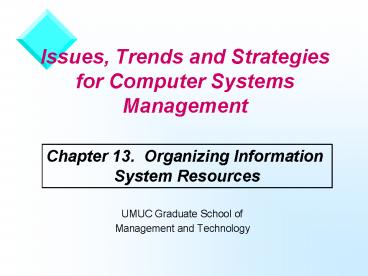Issues, Trends and Strategies for Computer Systems Management - PowerPoint PPT Presentation
1 / 26
Title:
Issues, Trends and Strategies for Computer Systems Management
Description:
Support manager $55,000. Help desk manager 47,500. Instructor 42,000 ... Does corporate culture support decentralization? Strengths. End users gain control. ... – PowerPoint PPT presentation
Number of Views:51
Avg rating:3.0/5.0
Title: Issues, Trends and Strategies for Computer Systems Management
1
Issues, Trends and Strategies for Computer
Systems Management
Chapter 13. Organizing Information System
Resources
- UMUC Graduate School of
- Management and Technology
2
Agenda
- Managing the Information Systems Function
- MIS Roles
- MIS Jobs
- Centralization and Decentralization
- Hardware
- Software
- Data
- Personnel
- Client-Server Solutions
- Object Orientation
- Change and Outsourcing
3
Organizing IS Resources
Strategy
Tactics
Operations
4
MIS Roles
- Hardware administration
- Software support
- Corporate data access
- Software development
- End user support
- Computing standards
- DB administration
- Advocacy
Advocacy
Corporate computing standards
Database administration
Access to corporate data
Software development
Hardware administration
Support end user development
Software training and support
5
Some MIS Roles
Hardware Repair
Network and Telecommunications
Training and User Support
6
Salaries1997-1998
IS Management
CIO/VP IS 126,000 Director MIS 94,000
Systems Development 79,500
Includes bonus
Networks
Systems Development
Database
Telecom. manager 71,000 Telecom.
specialist 56,500 Network architect 69,000 LAN/WAN
specialist 54,500 Network administrator 45,500
Sr. Project manager 72,000 Project
manager 61,500 Systems analyst 52,000 Programmer/a
nalyst 44,500 Programmer 36,000
Database manager 74,000 Database
administrator 61,000 Database analyst 55,000
Operations
User Support
Specialists
Senior manager 61,000 Manager 50,500 Lead
operator 35,000
Support manager 55,000 Help desk
manager 47,500 Instructor 42,000 PC technical
specialist 36,000
ERP analyst 80,000 CASE tools 61,000 Systems
programmer 54,000 Lotus Notes developer 52,500 Q/A
specialist 49,000 Webmaster 47,000
http//careers.wsj.com (Robert Half
1997) Computerworld 9/7/1998 http//www.computerwo
rld.com
7
International Salaries
The Economist 7/30/94
8
MIS Job Skills Needed
Arnett and Litecky, 1994
Computerworld, 1998
9
Complete Centralization
Hardware
Data and software
MIS personnel
User departments
10
Hardware CentralizationAdvantages
- Easier to share
- Data
- Expensive hardware (printers)
- Easier to control
- Purchases
- Usage
- Less duplication
- Efficiency less unused resources
11
Software CentralizationAdvantages
- Compatibility
- Bulk buying discounts
- Easier training
- Ease of maintenance upgrades
12
Data CentralizationAdvantages
- Easy backup
- Easier to Share
- Less duplication
- Security control\monitoring
13
Personnel CentralizationAdvantages
- Workers with similar backgrounds
- Easier training
- Straightforward growth path
- Specialized staff
- Easier to see/control costs
14
Growth of PCs
15
Complete Decentralization
Human Resource Management
MIS personnel are members of user departments
Finance
Marketing
Accounting
16
Hardware DecentralizationAdvantages
- Less chance of total breakdown
- Users get personalized equipment
- Micros are cheaper than mainframes
17
Software DecentralizationAdvantages
- Different users have different preferences
- Easier access
- Customization without affecting others
- Can overcome objections
- Lower prices minimize benefits of bulk purchases.
- Similarities of packages make training easier.
- Conversion tools enable sharing.
18
Data DecentralizationAdvantages
- Not all data needs to be shared
- Easier find and access
- Control politics
19
Personnel DecentralizationAdvantages
- Closer to users
- Faster response
- More time spent with users
- Better understanding/communication
- Different career path
20
Summary of MIS Organization
21
Intermediate (Client-Server)
Shared Data Software
Server Hardware
- Transaction processing
- Corporate standards
- Network management
- Shared databases
MIS support
Central MIS staff Operations, network and
systems programmers
Human Resource Management
MIS support
Finance
Marketing
Accounting
22
Client-Server Benefits
23
Decentralization Summary
Organizational Are operations interdependent?
-planning -development -physical resources
-operations Can subunits relate solely through
information messages? Does corporate culture
support decentralization?
Strengths End users gain control. Supports
workgroups. Enables new organizational
structures. Increased organizational flexibility.
Weaknesses Possible short term bias in decision
making. Might not be optimal use of resources
for corporation. IS staff might lose
cohesiveness and support.
24
Outsourcing
Forecast for 1999 42.6 billion
25
Outsourcing Evaluation
Specialized Talent Needed
Cost of reaching state of the art
When any of these characteristics increases
(moves outwards), there is less reason to use
outsourcing.
Security Control
Level of Technology
Fixed Costs
Complex Market Structure
26
OutsourcingForces
Globalization, new competitors.
Pressure on profits.
Need to focus on increasing revenues and
decreasing fixed/semi-fixed costs.
Shorter product life-cycles, mass customization.
Outsource non-revenue generate functions (staff/op
erations)
Rapidly changing markets, flexible manufacturing.
Need for flexibility and responsiveness.
Desire to minimize amount of management time
devoted to non-revenue generating functions.
Cost cutting, staff cuts, loss of middle
management.
Economies of Scale - leverage expertise and
methodologies. - invest in expensive
technologies (state-of-the-art) -
process-oriented approach
Economies of Scope Want one vendor to provide
multiple functions.
Big Outsourcing Vendors Big 6 Firms































